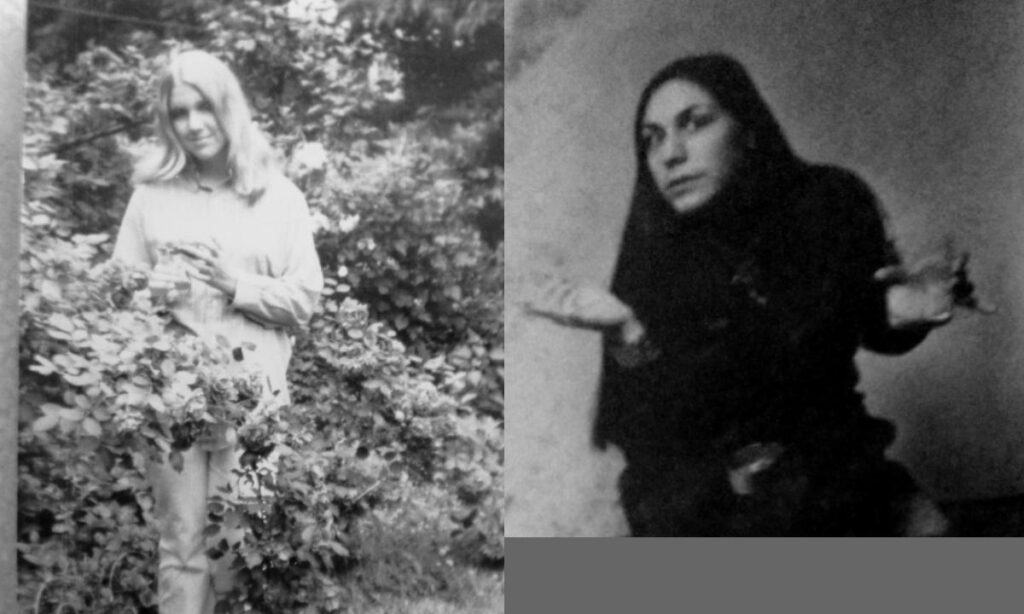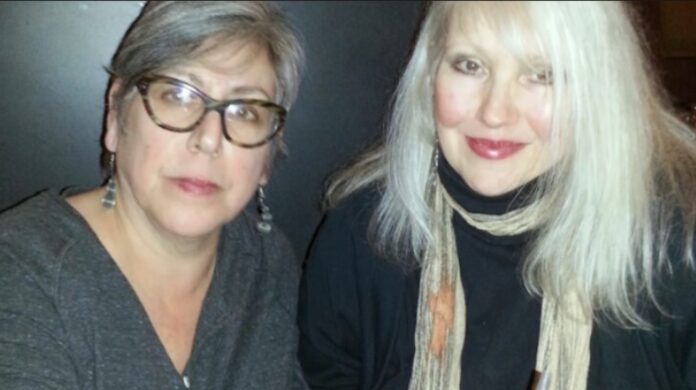In 1972, the year of the first Pride march in Philadelphia, we were impossibly young lovers, relentlessly star-crossed by our age and the homophobia all around us. I had already been expelled for being a lesbian from the Philadelphia High School for Girls (Girls’ High) where we were both students. She was still there, but I’d been banned from the campus and banned from her house and banned from having any girls at my house. My life was a continuing subversive battle to be a lesbian in a straight world that was in no way accepting of people like me, her, and those other people at that first march.
She and I would meet secretly where everyone met then, at Rittenhouse Square or at the head shops on Sansom Street like Ward’s Folly. Sometimes we’d be able to scrounge enough money panhandling to go eat at Day’s Deli, off the Square. It was always full of elderly Jewish ladies and young gay and trans people. She had bought me a ring at Harry North jewelers on Sansom Street, yet another counter-culture place where queer people were always in evidence. The ring was silver and had two amethysts — my birthstone. I still have it to this day. I was going to wear it when we renewed our vows at a wedding next year.
We gravitated to these places where people like us — other gay and lesbian people — were. We searched for gay books in bookstores and images of lesbians among the posters in the head shops. We tried to find a place for us to fit in, like the lyrics from Sondheim’s “Somewhere” in “West Side Story.”
Many decades later, in a year when a big Pride flag is draped across the portico of the White House, it’s complicated trying to articulate what it was like to be an out lesbian teenager in a still mostly closeted world a hot minute after Stonewall.
I met Maddy Gold on the 26 bus on the way to Girl’s High. She said she fell in love with me on that bus and never stopped loving me ever after. She had long, straight black hair and green eyes with flecks in them and she was mesmerizingly different from other girls I had gone to Catholic school with. She wore black turtlenecks with mini-skirts and black tights and she was the epitome of cool.
Maddy was a year ahead of me in school and lived just blocks from that Catholic school where I’d spent nine years being bullied for being smart and nerdy and openly promoting the politics of my Socialist Civil Rights worker parents and wearing SNCC pins on my school blazer. I’d been in a revolving door to Mother Superior’s office since 3rd grade and was almost kept from graduating with my 8th grade class after I reflexively slapped a nun for using the n word in the school yard.
It was a short bus ride from that Mount Airy school to Girls’ High at Broad and Olney. While there, I had learned everything there was to know about the female saints, like the one my school was named for. While there, I would learn how to be a lesbian.

There had been 13 girls in my 8th grade class. There were nearly 900 in my freshman class at Girls’ High. And where there had been rumors of lesbians at my K-12 Catholic school and some scandal that caused our rumored-to-be-lesbian gym teacher to change her name over the summer when we were in 6th grade, at Girls’ High there were closeted lesbian teachers who had been there since my mother was a student there. And there were other lesbian students. Like Maddy.
It was Maddy who slipped the clipping from the underground weekly The Distant Drummer into my locker that announced the first meeting of Radicalesbians. I was the only teenager to attend that first meeting above an adult bookstore at 9th and Chestnut in Center City. The other women were a little afraid of me — of my youth and of that outspokenness that had landed me in Mother Superior’s office.
We broke up into groups and I was dubbed “jail bait” by several women in my group, among whom was Arleen Olshan, who would later helm Giovanni’s Room bookstore for years and who was then an art student at Philadelphia College of Art (now University of the Arts), where both Maddy’s artist parents taught. Arleen was one of many older lesbians in Radicalesbians and the bar scene from whom I would learn how to be an out lesbian in a closeted society as she suggested books to me and where to find them.
Those early years post-Stonewall are rich with memories for me: Maddy and I are of that first generation of post-Stonewall queers. Stonewall announced us, but our whole adult lives were a struggle against the homophobia that followed us everywhere and interrupted our lives again and again. After her recent death I had to fight for her benefits, filling out forms that still say husband and wife seven years after Obergefell.
That first Pride march in Philly was electric. It was a gray and humid June Sunday in Rittenhouse Square where Maddy and I had met so many times before. This time there weren’t just a handful of other queer people. This time there were hundreds. I remember Barbara Gittings speaking and how rapt the crowd was.
Neither Maddy nor I had any sense of how significant that first march was. We were two teenagers in love, struggling against the homophobia all around us. We didn’t realize that we were in an historic moment engaged in the nascent movement for equality. Nor did we know that we would continue to fight for that same equality throughout our adult lives.
No doubt there are historical accounts of that first march that discuss who was there and how it was organized in detail. I remember being in planning meetings at Radicalesbians, but I don’t recall the details. Other groups that planned the march were Gay Activists Alliance, which I would join too, after RL disbanded, though few women were in the group and it never welcomed us.
That first march took a couple thousand of us from Rittenhouse Square to Independence Hall. Maddy and I held hands the whole way, two baby dykes finally allowed to be ourselves as we were surrounded by queer adults like us. She was nervous, afraid someone might recognize her and report back to her parents. I said if they were here, they weren’t going to be reporting to anyone, certainly not a colleague at their teaching job.
When we reached Independence Hall, I told her how my maternal grandfather, a historian who had died a few years before, had brought me there as a child at night to see the place lit up and tell me about the Declaration of Independence. We were there, Maddy and I, two teenagers in a sea of gay adults — more gay people than we had ever seen — and it was magical. It was incendiary, an experience to last us a lifetime. It was our first experience of being able to be ourselves, with our own people. To be out in the daylight holding hands and stealing a quick kiss and acknowledging ourselves in a way we had never been allowed to do ever before.
It’s impossible to explain how exciting that was, how surreal it was, how we wanted it to go on forever and not have to get on the subway and go home, each to our own houses, where we were expected to pretend we were something we were not.
Maddy and I loved each other at that first Pride march. We loved being surrounded by queer and trans people, loved the sense of belonging and being with our own people.
We would be married for 23 years, until her sudden death last November after battling a rare aggressive cancer. We would both be fired from jobs for being gay and we would fight to have our relationship validated and we would reminisce about those early years when we and the LGBTQ movement itself were so very young and finding our way in a homophobic world.
That Pride march taught us about the importance of being out, of showing straight people we belonged in their world. Maddy taught high school and college up until a few months before her death. She was that teacher who made a safe space for students to come out as queer and trans. She was all the things that people like Ron DeSantis and the GOP want to legislate against.
We lived the lives that first Pride march promised: We rejected the closet, rejected the hate, even as we fought it. That first Pride was like a first kiss — a passionate promise of a future. We had that future. And I fight on, in her name and so many other activists who have passed, so that other kids, like we were once, can have it too, fifty years after that first Pride.
